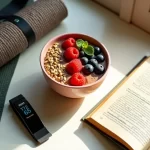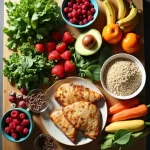Struggling to eat healthier but overwhelmed by complicated diets? What if one simple swap could dramatically improve your nutrition, energy levels, and waistline—without deprivation?
The secret? Replace refined grains with whole grains. This small change packs a massive punch, offering more fiber, nutrients, and long-lasting energy. Let’s dive into why this swap works, the science behind it, and how to make it stick—effortlessly.
Why Refined Grains Are Sabotaging Your Health
What Are Refined Grains?
Refined grains (white bread, white rice, pasta, pastries) are stripped of their bran and germ, removing most fiber, vitamins, and minerals. What’s left is quick-digesting starch that spikes blood sugar.
The Downsides of Refined Grains
- Blood sugar crashes → Energy slumps & cravings
- Low fiber → Poor digestion & overeating
- Nutrient-deficient → Missing key vitamins like B and iron
The Power of Whole Grains: Why This Swap Works
What Makes Whole Grains Superior?
Whole grains (quinoa, brown rice, oats, whole wheat) keep all three parts of the grain:
✅ Bran (fiber & antioxidants)
✅ Germ (healthy fats & vitamins)
✅ Endosperm (starch for energy)
5 Science-Backed Benefits of Switching to Whole Grains
- Stable Energy Levels – Fiber slows digestion, preventing sugar crashes.
- Better Digestion – Promotes gut health and regularity.
- Weight Management – Keeps you fuller longer, reducing overeating.
- Lower Disease Risk – Linked to reduced heart disease & diabetes risk.
- Longer Lifespan – Studies show whole grains may increase longevity.
Easy Whole Grain Swaps You Can Make Today
| Instead of… | Try This! |
|---|---|
| White bread | 100% whole wheat or sprouted grain bread |
| White rice | Brown rice, quinoa, or farro |
| Regular pasta | Whole wheat or chickpea pasta |
| Sugary cereal | Steel-cut oats or bran flakes |
| White flour tortillas | Whole grain or corn tortillas |
Pro Tip: Start with one swap per meal to ease into the transition.
Common Myths About Whole Grains (Debunked!)
❌ “Whole grains taste bland.” → Try farro, wild rice, or whole wheat couscous—they’re nutty and flavorful!
❌ “They take too long to cook.” → Use a rice cooker or pre-cook batches for the week.
❌ “Gluten-free means healthier.” → Many gluten-free products are still refined (opt for quinoa or buckwheat instead).
How to Make the Swap Stick (Without Feeling Deprived)
1. Start Small
- Swap just breakfast first (e.g., white toast → oatmeal).
- Gradually replace other meals.
2. Experiment with Flavors
- Add herbs, spices, or healthy fats (avocado, olive oil) to enhance taste.
3. Read Labels Carefully
- Look for “100% whole grain”—not just “multigrain” (which can still be refined).
4. Meal Prep for Success
- Cook a big batch of quinoa or brown rice for easy meals all week.
FAQs About Whole Grains
1. Are whole grains good for weight loss?
Yes! Their high fiber content helps control hunger and reduce calorie intake.
2. Can I eat whole grains if I’m gluten-sensitive?
Absolutely—opt for quinoa, buckwheat, or gluten-free oats.
3. Do whole grains cause bloating?
Some people need to adjust gradually—start with small portions and drink plenty of water.
4. How much whole grain should I eat daily?
Experts recommend at least 3 servings (48g) per day for optimal health.
5. Are “ancient grains” better than regular whole grains?
They’re great (e.g., spelt, amaranth), but any whole grain is better than refined!
Conclusion: One Swap, Endless Benefits
Switching from refined to whole grains is the easiest, most impactful change you can make for your diet. Better energy, improved digestion, and long-term health benefits—all from one simple tweak.
Your Action Plan:
✔ Pick one refined grain in your diet and swap it today.
✔ Experiment with new whole grains (try farro or barley!).
✔ Notice the difference in how you feel after just a week.
Ready to revolutionize your diet? Start with one swap and let the benefits unfold!
For more healthy eating tips, check out:
Your body (and taste buds) will thank you! 🌾















